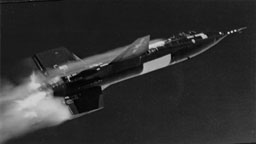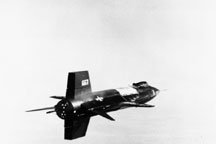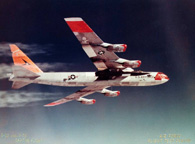

The first powered flight of the X-15-1 was conducted on January 23, 1960. Fitzhugh Fulton and Captain Charles Kuyk launched Scott Crossfield from the NB-52B on mission 1-2-7*. Crossfield reached a speed of Mach 2.53 and an altitude of 66,844 feet during 4 minutes and 27 seconds of rocket-powered flight. The only pilots to have flown faster were Pete Everest, Ivan Kinchloe, and Mel Apt in the X-2 in 1956.
 X-15-1 in powered flight. Photo courtesy AFFTC/HO.
X-15-1 in powered flight. Photo courtesy AFFTC/HO.
The X-15-2 was mated to the NB-52B for a powered flight attempt on February 4, 1960. Numerous systems failures resulted in the scrubbing of the mission.
After a week of making repairs to the X-15-2, it was carried aloft by the NB-52B on February 11. Major Jack Allavie was at the controls of the mother plane, and Fitzhugh Fulton was the co-pilot. The flight plan incorporated a loiter at the launch altitude to simulate the length of time that it would take to carry the X-15 to the launch lakes used for future high performance flights. The X-15 systems cooperated, and mission 2-4-11 was conducted successfully. Crossfield triggered the launch from the X-15 cockpit, a procedure which would become the standard method. The power of the twin XLR-11 rocket engines propelled the X-15 to an altitude of 88,116 feet. Crossfield leveled out and accelerated to mach 2.22 (1,466 miles per hour) on a flight that was considered a complete success.
Six days later, Fulton and Allavie had switched positions in the NB-52B for mission 2-5-12. After launch, one of the thrust chambers of the upper XLR-11 engine of the X-15-2 shut down part way through the burn. The thrust available to the X-15-2 was reduced, but the time of the burn was correspondingly lengthened. The reduced thrust resulted in a modest speed of mach 1.57 (1,036 miles per hour), one of the slowest powered flights of the X-15 program. The X-15-2 climbed only a mile and a half above the launch altitude, reaching 52,640 feet.
 X-15-2 running on seven of the
eight thrust chambers. Photo courtesy AFFTC/HO.
X-15-2 running on seven of the
eight thrust chambers. Photo courtesy AFFTC/HO.
High winds at Edwards AFB canceled the next two launch attempts scheduled on February 25 and 26. It was not until March 17 that Major Allavie and Captain Kuyk launched Crossfield in the X-15-2 from the NB-52B on mission 2-6-13. The systems of the X-15-2 performed flawlessly on a flight that reached mach 2.15 (1,419 miles per hour).
The ground crew turned the X-15-2 around overnight for another launch attempt the following day. Major Allavie and Captain Kuyk were assigned to fly the NB-52B. The X-15 systems were prepared for launch when Al White in the chase plane noticed alcohol leaking out of a drain from the X-15 engine bay. A fitting in the fuel plumbing had cracked and alcohol was pooling in the bay. There was great danger of an explosion of the vapors in the engine bay, so the launch was aborted just seconds before the drop.
North American delivered the X-15-1 to NASA in January 1960. For the first time, a pilot other than Scott Crossfield would fly the black missile. Joe Walker, a NASA pilot, had acquired plentiful rocket plane experience in the X-1E. Joe Walker was scheduled to make the first flight of an X-15 by a NASA pilot on March 23, but bad weather forced the flight to be postponed for two days. On March 25, Major Allavie and Fitzhugh Fulton piloted the NB-52B around a racetrack course as Walker familiarized himself with the systems of the rocket plane. After launch, Walker flew the X-15-1 to mach 2 (1320 miles per hour) and an altitude of 48,630, only slightly higher than the launch altitude. Walker's flight marked the beginning of NASA's expansion of the envelope of X-15 operations with the interim XLR-11 engine installation.
Four days after Joe Walker's first flight in the X-15-1, Fulton and Allavie launched Scott Crossfield from the NB-52B in the X-15-2. The flight was for the purpose of establishing the behavior of the black rocket at the high angle of attack that would be encountered on pullouts from high altitude. Crossfield performed a series of dives and pullouts, pulling up to six gees on the pullouts. The X-15-2 was turned around in two days and Crossfield made another flight on March 31.
Air Force Major Robert White was scheduled to become the third pilot to fly the X-15 on April 12, but high winds in the desert caused the flight to be rescheduled for the following day. On April 13, Major Allavie and Captain Kuyk were at the controls of the NB-52A as it flew with an X-15 on the pylon for the first time in five months. On Major White's familiarization flight, he kept the speed of the X-15-1 down to mach 1.9 (1,254 miles per hour) and only climbed three thousand feet above the altitude at which he had been launched.
 The NB-52A carrying the X-15-1 on April 13,
1960. The yellow NASA tailband has been added to the tail of the
X-15. The area above the cockpit of the NB-52A has been painted
white to alleviate the heat on the flightline at Edwards Air
Force Base. Photo EC88-180-04 downloaded from the
NASA Dryden Photo Server.
The NB-52A carrying the X-15-1 on April 13,
1960. The yellow NASA tailband has been added to the tail of the
X-15. The area above the cockpit of the NB-52A has been painted
white to alleviate the heat on the flightline at Edwards Air
Force Base. Photo EC88-180-04 downloaded from the
NASA Dryden Photo Server.
On April 19, Joe Walker flew the X-15-1 to a new program speed record of mach 2.56 ( 1,689 miles per hour) after launch from the NB-52A on his second X-15 flight.
*The first position of the mission number identifies which X-15 was involved, the second number indicates how many times that X-15 had been launched, and the third number indicates how many times it had been carried by an NB-52.
Send a message to Brian
Go to home page of the Goleta Air & Space Museum.
Edited April 16, 2000.